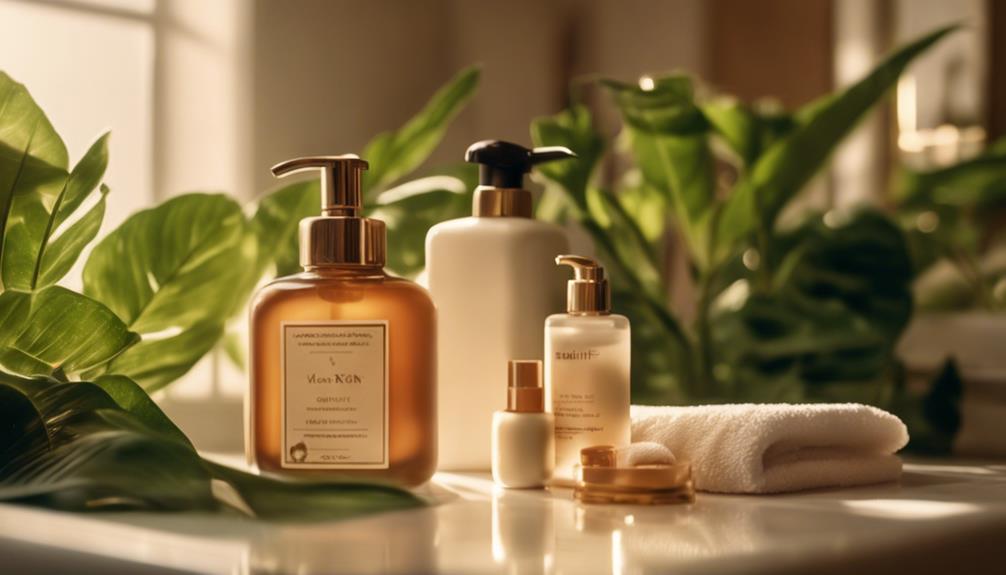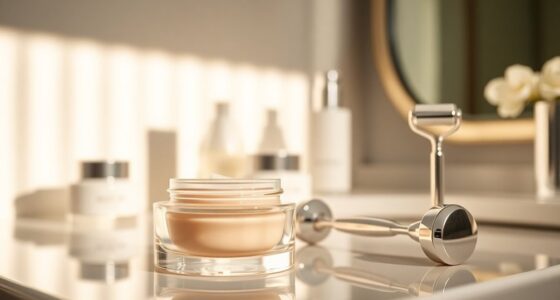To achieve radiant skin, you need the right tanning lotion. Look for products with hydrating ingredients like aloe vera and coconut oil, plus boosters like DHA and tyrosine for an instant and lasting tan. Consider options like b.tan Best Tanning Oil or Sun Bum Browning Lotion for added nourishment and ethical choices. Always apply evenly and use SPF to protect your skin from harmful rays. Remember to exfoliate beforehand for smooth results. With so many great options available, you're sure to find one that fits your skin's needs perfectly and contributes to a glowing appearance. There's more to explore!
Key Takeaways
- Look for tanning lotions with hydrating ingredients like aloe vera and coconut oil for enhanced skin radiance.
- Consider natural formulas that nourish skin without harsh chemicals for a healthier tan.
- Choose products with DHA and tyrosine to achieve a deeper, long-lasting tan.
- Ensure the lotion has SPF protection to prevent sunburn and maintain skin health.
Key Ingredients to Look For
When choosing a tanning lotion, you'll want to look for skin-nourishing ingredients like aloe vera, coconut oil, and vitamins C and E to guarantee your skin stays hydrated and radiant.
DHA (Dihydroxyacetone) is also essential; it provides immediate color while promoting a gradual tan.
Tyrosine, an amino acid, helps boost melanin production for a deeper tan.
Natural oils, such as argan and jojoba, offer additional hydration and nourishment.
Antioxidants like tea tree oil protect your skin from damage caused by free radicals during sun exposure.
Finally, consider Kakadu plum extract for its antioxidant properties and skin benefits.
These key ingredients not only enhance your tan but also maintain your skin's health and appearance.
Different Types of Tanning Lotions
Understanding the key ingredients in tanning lotions sets the stage for exploring the various types available, each designed to cater to different tanning needs and preferences.
You'll find accelerator lotions that speed up the tanning process, often featuring bronzers for instant color, like Australian Gold Dark Tanning Accelerator Lotion.
Natural formulas, such as Maui Babe Browning Lotion, focus on hydration and skin health, often free from harsh chemicals.
If you're looking for ethical options, vegan and cruelty-free products like b.tan Best Tanning Oil Dry Spray provide great results without animal testing.
Application Techniques for Best Results
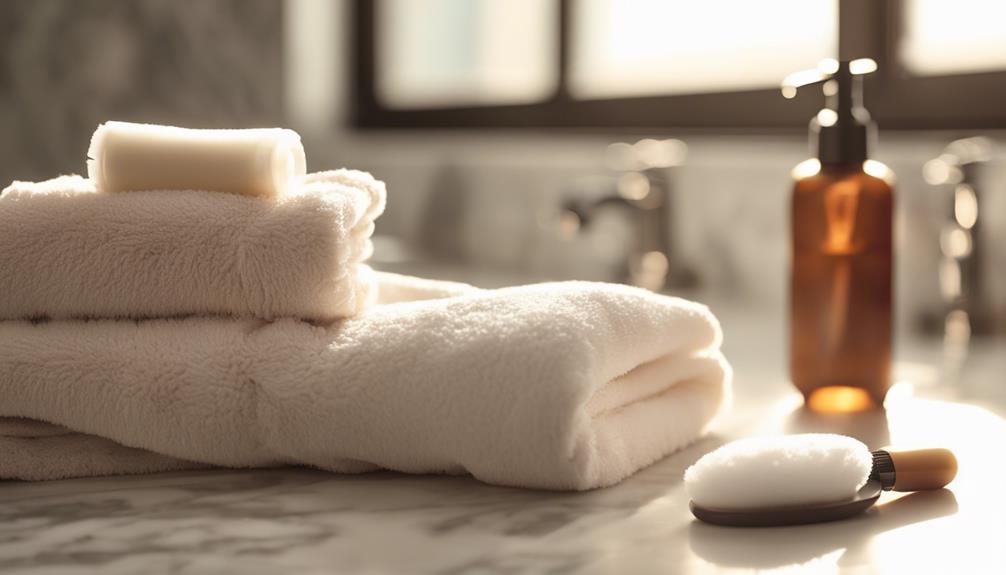
To achieve the best tanning results, apply the lotion generously and evenly across your skin.
Start by exfoliating to remove dead skin cells, ensuring a smoother application.
Use gloves or wash your hands immediately after applying to prevent discoloration.
Focus on one area at a time, blending thoroughly to avoid streaks.
Reapply every two hours, especially if you're swimming or sweating.
For ideal results, avoid tanning during peak sun hours, typically between 10 AM and 4 PM.
Remember to pay attention to areas that can be easily overlooked, like your elbows and knees.
Following these techniques will help you achieve a beautiful, even tan while keeping your skin healthy and radiant.
The Role of SPF in Tanning
Incorporating SPF into your tanning routine is essential for protecting your skin from harmful UV rays while you achieve that desired glow. Using a broad-spectrum SPF not only helps prevent sunburn but also reduces your risk of skin cancer.
Here are four reasons why SPF is vital for your tanning process:
- Peace of Mind: Knowing you're protecting your skin allows you to enjoy the sun without worry.
- Longer-lasting Tan: Proper protection helps maintain your tan by preventing peeling and damage.
- Youthful Skin: Regular SPF use helps prevent premature aging and keeps your skin looking radiant.
- Confidence Boost: With healthy, glowing skin, you'll feel more confident showing off your tan!
Possible Side Effects of Tanning Lotions
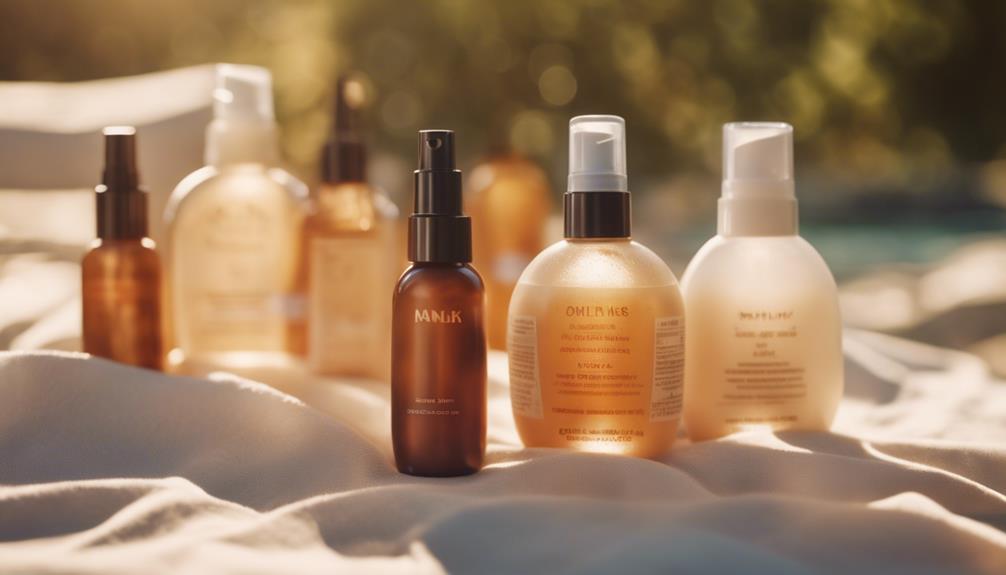
While SPF is essential for protecting your skin during tanning, it's also important to be aware of the potential side effects that can arise from using tanning lotions. You might experience skin irritation or allergic reactions to certain ingredients, which can be uncomfortable. Additionally, improper application can lead to staining of your clothing and bedding. Not using adequate sun protection can increase your risk of sunburn. Temporary discoloration of your palms or nails may occur, and sensitive skin types could face clogged pores leading to breakouts.
| Side Effect | Description |
|---|---|
| Skin Irritation | Redness or rashes from allergic reactions |
| Staining | Discoloration of fabrics and bedding |
| Sunburn Risk | Increased likelihood without adequate SPF |
| Clogged Pores | Breakouts in sensitive skin types |
Tips for Safe Tanning Practices
Prioritizing safety during tanning can help you achieve a beautiful glow without compromising your skin's health. Here are some essential tips to keep in mind:
- Always use SPF: Protect your skin from harmful UV rays, even when using tanning lotions.
- Hydrate and moisturize: Keep your skin hydrated for a deeper, more even tan.
- Limit sun exposure: Tanning in moderation can reduce the risk of sunburn and skin damage.
- Check for skin changes: Regularly inspect your skin for any unusual spots and consult a dermatologist if anything seems off.
Overview of Popular Tanning Products
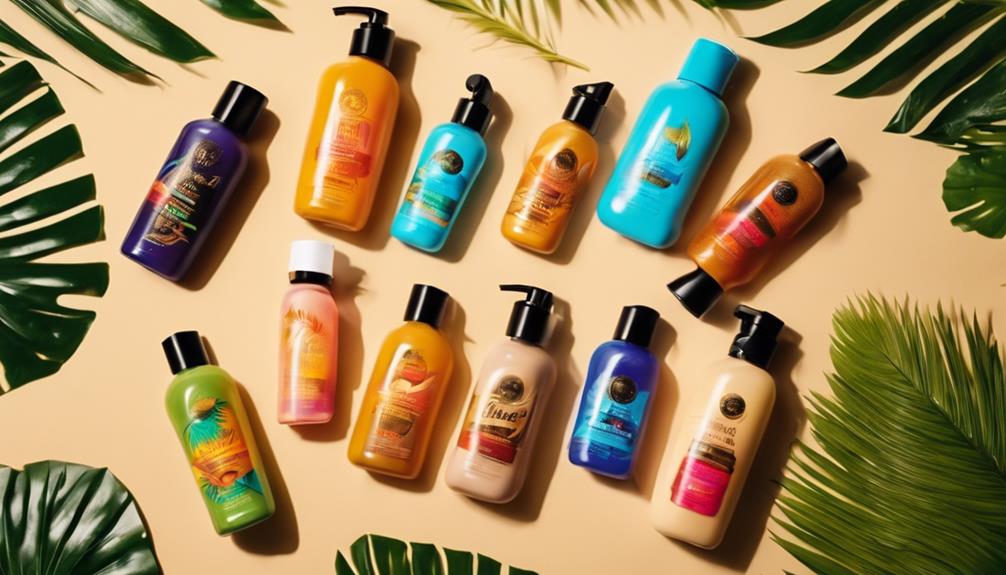
When choosing a tanning product, you'll find a variety of popular options that cater to different preferences and skin types.
For a quick tan, consider b.tan Best Tanning Oil Dry Spray, which hydrates with coconut and jojoba oils.
If you're looking for an intensifier, Australian Gold Rapid Tanning Intensifier Lotion combines Tea Tree Oil and Vitamin E for added moisture.
The Maui Babe Browning Lotion stands out as an all-natural choice, providing ultra-hydration and water resistance.
Alternatively, Sun Bum Browning Lotion offers a vegan option enriched with Aloe Vera and Kona Coffee.
For deep tanning, try Carroten Intensive Tanning Gel, featuring an SPF 0 formula.
Each product has unique benefits, allowing you to find the perfect match for your tanning needs.
Factors to Consider When Choosing
Choosing the right tanning lotion involves considering several factors to guarantee you achieve your desired tan while maintaining skin health. Here's what you should keep in mind:
- SPF Level: Verify it matches your skin type to protect against harmful UV rays.
- Skin Nourishing Ingredients: Look for moisturizing elements like aloe vera and coconut oil to keep your skin hydrated.
- Tanning Accelerators: Choose lotions that help you achieve a deeper tan faster, making the process more satisfying.
- Application Ease: A lotion that spreads smoothly will give you a more even and beautiful tan, enhancing your overall experience.
Frequently Asked Questions
How Long Does a Tanning Lotion Tan Typically Last?
A tanning lotion tan typically lasts about five to ten days, depending on your skin type and care. To maintain it longer, keep your skin moisturized and exfoliate gently to avoid uneven fading.
Can I Use Tanning Lotion on My Face?
Yes, you can use tanning lotion on your face, but choose a product specifically formulated for facial skin. It's usually gentler and designed to prevent breakouts while providing a natural, even tan.
Are There Tanning Lotions for Sensitive Skin?
About 50% of people have sensitive skin, so yes, there are tanning lotions specifically formulated for it. Look for hypoallergenic options with natural ingredients to minimize irritation while achieving that sun-kissed glow you want.
Will Tanning Lotions Protect Against Sunburn?
Tanning lotions alone won't protect you from sunburn. They may enhance your tan, but you still need a broad-spectrum sunscreen with SPF to shield your skin from harmful UV rays and prevent sunburn.
How Often Should I Reapply Tanning Lotion?
Reapplying tanning lotion is like watering a plant; it needs consistent care. You should reapply every two hours, especially after swimming or sweating, to guarantee your tan stays vibrant and even.
Conclusion
As you navigate the world of tanning lotions, think of your skin as a canvas waiting for the perfect masterpiece.
By choosing the right product and following safe tanning practices, you can create a radiant glow that reflects your inner beauty.
Remember, it's not just about achieving a bronzed look; it's about nurturing your skin along the way.
So, embrace the journey and let your sun-kissed glow shine brightly, while keeping your skin healthy and vibrant.

